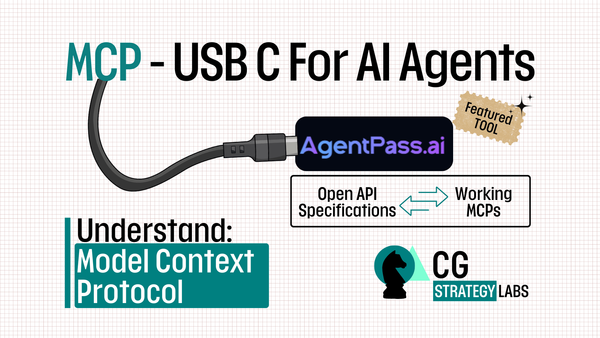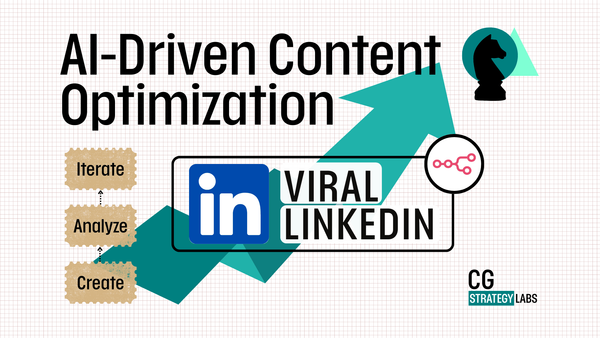Learning to Build AI Agents That Actually Scale

A Strategic Framework that allows you to move beyond basic automations and learn 'Building AI Agents That Actually Scale'
The Strategic Learning Paradox in AI
- You're a Product Manager who wants to build AI agents that can qualify leads automatically.
- Or a Growth Marketer dreaming of AI systems that create personalized campaign sequences.
- Maybe you're an AI enthusiast who knows there's more potential beyond simple "if this, then that" workflows.
Here's what typically happens:
You start with drag-and-drop tools like n8n or Zapier. You wire up a few nodes, connect some APIs, and suddenly you have an "AI agent" that works for basic tasks.
It feels like magic initially. But then you hit the wall.
You want to build something more sophisticated - maybe an agent that can analyze customer feedback and automatically prioritize product features, or a marketing AI that adapts campaigns based on real-time performance data.
You try to extend your simple automation, but you're stuck.
The problem isn't the tools. It's the approach.
Before you go ahead, c our AI ebook to learn AI concepts practically:
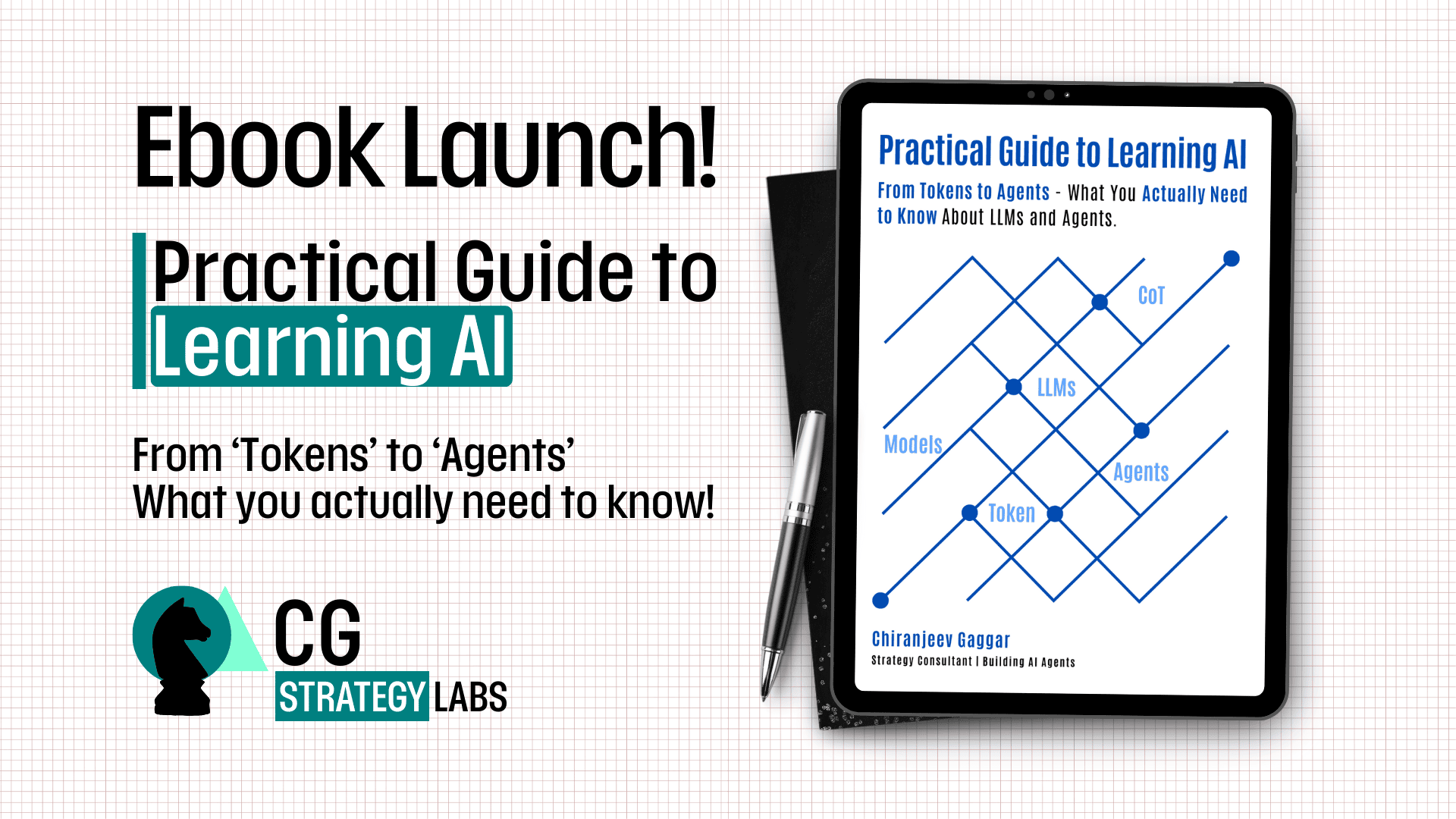
Why Most People Get Stuck at Basic Automations?
After building dozens of AI agents and helping others through this journey, I've identified the core issue: most people start with the wrong learning philosophy.

The Tool-First Trap
Here's the typical progression I see:
- Excitement Phase: Discover visual AI builders → Build first basic automation → Feel accomplished
- Ambition Phase: Want to build something more complex → Try to extend existing simple automation
- Frustration Phase: Hit technical limitations → Don't understand why it's not working → Give up or settle for basic
The Hidden Problem
Visual builders like n8n, Zapier, and Make are incredible tools. They democratize AI by hiding complexity. But this strength becomes a weakness when you want to scale beyond basics.
What these tools hide:
- How LLM APIs actually work
- What "tool calling" means and how agents use tools
- Why certain agent architectures work better for different problems
- How to debug when things break in complex workflows
- The foundational concepts needed for advanced implementations
The result: You can copy tutorials, but you can't create solutions for your specific business problems.
A 5-Step Strategic Framework for Learning to Build AI Agents
Based on my experience building AI agents for business applications, here's the learning framework I wish I had started with. This approach focuses on concepts over tools - understanding the "why" behind AI agent architecture.
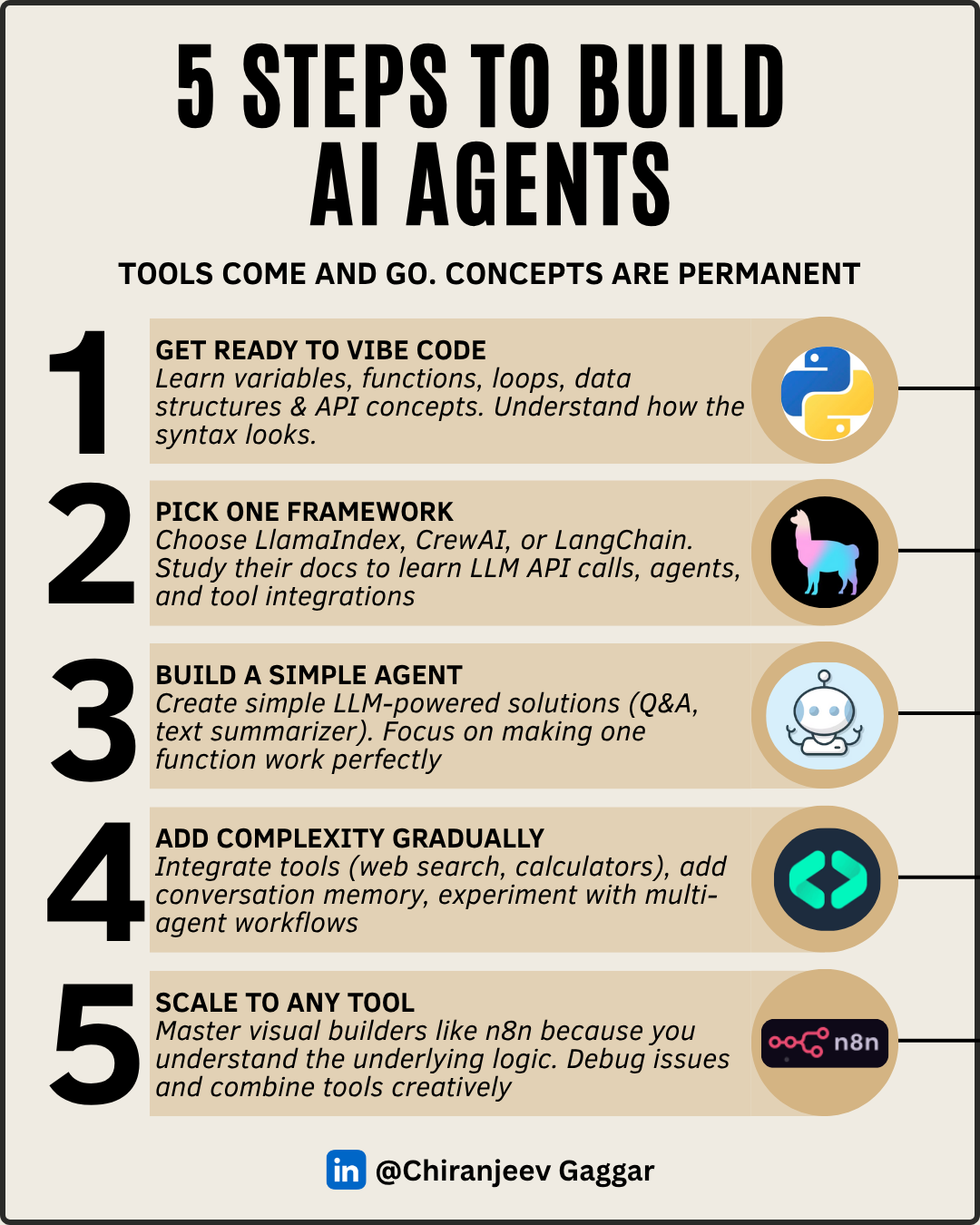
Step 1: Foundation - Get Ready to "Vibe Code"
You don't need to become a developer, but you need to understand what developers are doing.
What to Learn:
- Variables and Data Types: How information flows through systems
- Functions: How to break complex problems into smaller pieces
- Loops and Conditions: How to make decisions and repeat actions
- Data Structures: Lists, dictionaries - how to organize information
- API Concepts: How different systems talk to each other
- JSON: The language of data exchange
Practical Goal: Read code examples without panic. Understand what's happening in AI framework documentation.
Time Investment: 2-3 weeks of casual learning (20-30 minutes daily)
Business Value: This foundation lets you understand technical documentation, debug issues, and communicate effectively with developers.
Step 2: Framework Selection - Choose Your Go To Framework
Master one framework deeply rather than jumping between multiple tools.
Recommended Frameworks:
- LlamaIndex: Best for RAG (document-based) applications
- CrewAI: Excellent for multi-agent business workflows
- LangChain: Most comprehensive but steeper learning curve
Strategic Approach:
- Read Documentation Like a Manual: Framework docs aren't just code - they explain core concepts
- Understand the Architecture: How does this framework structure AI agent thinking?
- Learn the Patterns: What problems does this framework solve best?
Key Concepts to Master:
- How to call LLMs via API
- What are "tool calls" and how do agents use tools
- How agents make decisions and execute actions
- Memory management and conversation flow
Business Application: You'll understand why certain agent architectures work better for different business problems.
📁 Need help choosing? Check out my AI Framework Selection Guide for detailed business-context comparisons.
Step 3: Implementation - Build Your First Simple Agent
Philosophy: Start with basic LLM interactions. Master the fundamentals before adding complexity.
Simple Starting Projects:
- Question-Answer Agent: Send a question, get a structured response
- Text Summarizer: Input long content, get concise summaries
- Format Converter: Transform data from one format to another
- Simple Classifier: Categorize text into predefined buckets
Technical Focus:
- Basic LLM Calls: Learn to send prompts and receive responses
- Prompt Engineering: Understand how to structure requests for consistent outputs
- Response Handling: Parse and use the LLM's output in your code
- Error Management: Handle API failures and unexpected responses
Success Metric: Your agent / workflow consistently performs one simple task reliably.
Step 4: Scaling - Add Strategic Complexity
Philosophy: Layer complexity gradually, always with business justification.
Strategic Enhancements:
- Tool Integration: Web search for real-time data, calculators for analysis
- Memory Systems: Context awareness across conversations and sessions
- Multi-Agent Workflows: Specialized agents working together on complex problems
- Business Logic: Decision trees that mirror your actual business processes
Advanced Patterns:
- Supervisor Agents: Route tasks to specialized sub-agents
- Feedback Loops: Agents that learn from outcomes and improve performance
- Human-in-the-Loop: Strategic checkpoints for high-stakes decisions
Business Impact: Your AI systems start handling complete workflows, not just individual tasks.
Step 5: Tool Mastery - Scale Across Any Platform
Philosophy: Now you can use any tool effectively because you understand the underlying principles.
Why This Step Works?
- Visual Builders Make Sense: You understand what's happening "under the hood" in n8n workflows
- Debugging Capability: You can identify and fix issues instead of starting over
- Creative Combinations: You can architect solutions using multiple tools strategically
- Technology Agnostic: You can evaluate new AI tools based on capabilities, not marketing
Strategic Advantage: You become the person who can bridge business requirements with technical implementation across any platform.
The Strategic Principle: Concepts Over Tools
Throughout this journey, remember the core philosophy that drives AI expertise:
"Tools Come and Go. Understanding Is Permanent"
Some Common Pitfalls to Avoid
Pitfall 1: Jumping to Advanced Too Quickly
Problem: Trying to build complex multi-agent systems before understanding basic LLM interactions
Solution: Spend extra time on Steps 1-2. Build 3-5 simple agents before attempting complex workflows
Pitfall 2: Tool Obsession
Problem: Constantly switching frameworks instead of deepening expertise Solution: Commit to one framework for 2-3 months. Master it before exploring alternatives
Pitfall 3: Tutorial Dependency
Problem: Only building exact replicas of tutorials without understanding principles
Solution: After following a tutorial, modify it for your specific business problem
Pitfall 4: Perfectionism Over Progress
Problem: Waiting to understand everything before building anything
Solution: Build imperfect solutions that solve real problems. Iterate based on usage
CG Strategy Lab explores practical AI implementation insights that bridge strategy and execution. Connect with me on LinkedIn if you'd like to discuss this topic further.


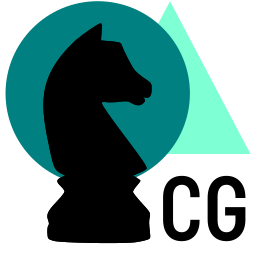
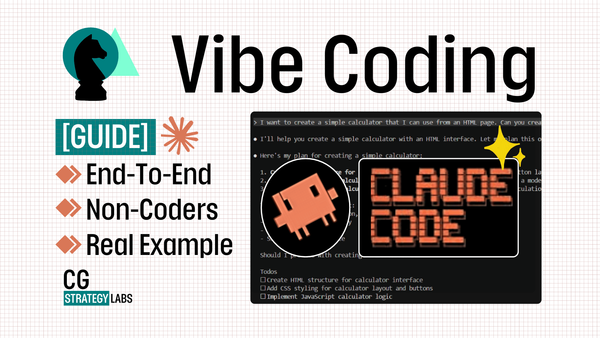
![Practical Guide to Learning AI: From Tokens to Agents [ebook]](/content/images/size/w600/2025/08/Blog-Featured-Images...--4-.png)
